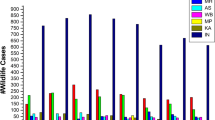Abstract
This paper presents data about wildlife crime in Croatia. The data were gathered from qualitative interviews and personal communications with individuals involved in wildlife crime-related research, and/or prevention and detection work or recreation. The results show that poaching is a recognized problem. There is a variety of commonly poached mammals, fish and bird species. We conclude that evidence about wildlife crime should be collated drawing on forensic techniques.
Similar content being viewed by others
References
United Nations 2020 Sustainable development goals knowledge platform. Sustain Dev Goal 14. https://www.un.org/development/desa/disabilities/envision2030-goal14.html. Accessed 23 July 2020.
United Nations 2020 Sustainable development goals knowledge platform. Sustain Dev Goal 15. https://www.un.org/development/desa/disabilities/envision2030-goal15.html. Accessed 23 July 2020.
Wilson-Wilde L. Combating wildlife crime. Forensic Sci Med Pathol. 2010;6:149.
Pearl M. Wildlife trade: threat to global health. EcoHealth. 2004;1:111–2.
Wellsmith M. Wildlife crime: the problems of enforcement. Eur J Crim Policy Res. 2011;17:125–48.
Cvrtila V. Croatia – the “gateway” to Southeast Europe. Politička Misao. 2000;5:150–9.
Huber D, Kusak J, Majic-Skrbins A, Majnaric D, Sindicic M. A multidimensional approach to managing the European brown bear in Croatia. Ursus. 2008;19:22–32.
CITES (the convention on international trade in endangered species of wild fauna and flora). https://www.cites.org/eng/disc/parties/chronolo.php. Accessed 23 Jan 2020.
European Commission 2020 EU action plan against wildlife trafficking. https://ec.europa.eu/environment/cites/trafficking_en.htm. Accessed 23 Jan 2020.
TRAFFIC 2016 The illegal trade in wild birds for food through south east and Central Europe. https://www.traffic.org/site/assets/files/3754/illegal_trade_wild_birds_for_food_europe.pdf. Accessed 23 Jan 2020.
Kecse-Nagy K, Papp D, Knapp A, von Meibom S. Wildlife trade in Central and Eastern Europe. A review of CITES implementation in 15 countries. Budapest: TRAFFIC Europe Report; 2006.
United Nations wildlife and forest crime analytic toolkit. Revised edition. https://www.unodc.org/documents/Wildlife/Toolkit_e.pdf. Accessed 23 July 2020.
Coghlan ML, White NE, Parkinson L, Haile J, Spencer PBS, Bunce M. Egg forensics: an appraisal of DNA sequencing to assist in species identification of illegally smuggled eggs. Forensic Sci Int. 2012;6:268–73.
Singh G, Srinivas Y, Kumar GC, Singh A, Sharma CP, Gupta SK. Identification of selected wild felids using hair morphology and forensically informative nucleotide sequencing (FINS): wildlife forensics prospective. Legal Med. 2020;44:101692.
Omel’yanyuk GG, Khaziev SN, Gulevskaya VV. Forensic assistance in the investigation of crimes against tigers. Теория и практика судебной экспертизы. 2017;12:18–26.
Anderson G. Wildlife forensic entomology: determining time of death in two illegally killed black bear cubs. J Forensic Sci. 1999;44:856–9.
Yadav S, Dixit AK. Forensic approaches in the solution of wildlife crime. Int J Multidiscip Res Dev. 2016;3:89–93.
Acknowledgements
The authors would like to thank Ryan Dallas and Mary Pilkinton for their assistance with the early stages of the research as well as the research participants for generously providing their time and expertise.
Funding
The research was supported by a UIC International Links grant from the University of Wollongong.
Author information
Authors and Affiliations
Corresponding author
Ethics declarations
Ethical approval
All procedures performed in studies involving human participants were in accordance with the ethical standards of the UOW Social Sciences and Humanities HREC and with the 1964 Helsinki declaration and its later amendments or comparable ethical standards.
Additional information
Publisher’s note
Springer Nature remains neutral with regard to jurisdictional claims in published maps and institutional affiliations.
Rights and permissions
About this article
Cite this article
Hanley, N., Mikac, K.M. Wildlife crime in Croatia. Forensic Sci Med Pathol 16, 702–704 (2020). https://doi.org/10.1007/s12024-020-00293-6
Accepted:
Published:
Issue Date:
DOI: https://doi.org/10.1007/s12024-020-00293-6




